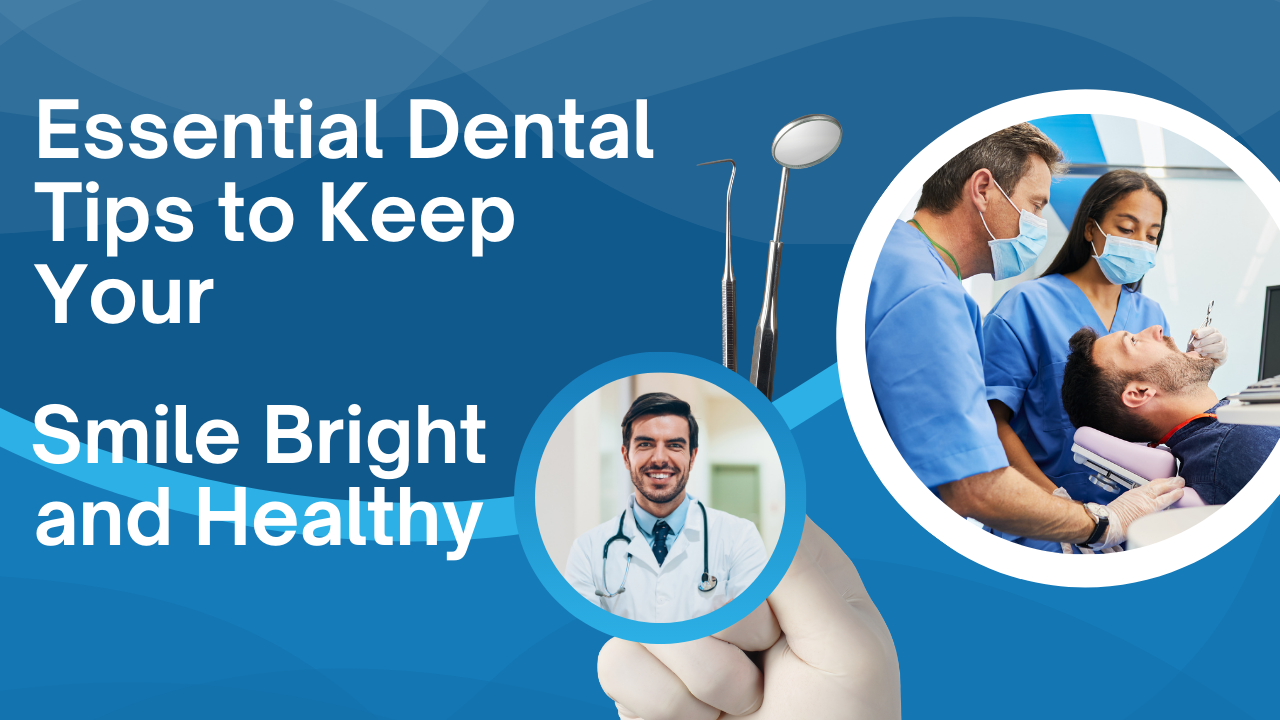A bright, healthy smile is more than just a cosmetic feature—it reflects your overall health and well-being. Good dental care boosts your confidence, enhances self-esteem, and supports general health. Unfortunately, many people overlook their dental hygiene, which can lead to common issues like cavities, gum disease, and bad breath.
Maintaining excellent dental health doesn’t have to be complicated. Simple daily habits such as brushing twice a day, flossing regularly, and limiting sugary snacks can make a significant difference. Visiting your dentist at least twice a year for checkups and cleanings is also vital to detect and prevent problems early.
With consistency and the right approach, anyone can achieve a radiant smile and strong gums. This guide will share practical dental health tips to help you stay on top of your oral hygiene routine. By taking small steps each day, you can keep your teeth looking great and your dental health in peak condition.
The Foundation: Brushing Your Teeth Properly

Brushing your teeth is the foundation of a strong dental care routine, but technique matters just as much as consistency. While many people brush daily, they often miss the mark on doing it effectively. Using the right method—brushing for two minutes, twice a day, with gentle circular motions—helps remove plaque and protects your teeth and gums from future problems.
- Choose the Right Toothbrush and Toothpaste
Choosing the right toothbrush is essential for maintaining good dental health. A soft-bristled toothbrush is generally the best option for most people, as it’s gentle on the gums and enamel while still being effective at removing plaque. It’s also helpful to choose a toothbrush with a small head, which makes it easier to clean hard-to-reach areas of your mouth thoroughly.
Electric toothbrushes can be a smart addition to your dental care routine. They are especially effective at removing plaque with less effort compared to manual brushes. Many models include built-in timers to ensure you’re brushing for the recommended two minutes, which helps maintain consistent and thorough cleaning. Their ease of use makes them a great choice for both adults and children.
When it comes to toothpaste, always look for one that contains fluoride. Fluoride strengthens enamel and helps prevent cavities. If you’re interested in a brighter smile, whitening toothpastes can lift surface stains over time. Just remember, these products are most effective when used as part of a complete dental hygiene routine.
- Brush Twice a Day
Brushing your teeth twice a day is a key part of maintaining good dental health. It’s important to brush once in the morning and again before going to bed to keep your mouth clean and fresh throughout the day and night.
Morning brushing helps eliminate the bacteria that build up in your mouth while you sleep. This not only freshens your breath but also sets the tone for a healthy dental routine throughout the day.
Brushing at night is just as important, as it clears away food particles and plaque that collect throughout the day. Make sure to brush for at least two minutes, covering all areas of your mouth to support a strong, effective dental care routine.
- Technique Matters
Proper brushing technique is just as important as brushing regularly. Hold your toothbrush at a 45-degree angle to your gums and use gentle, circular motions. Avoid brushing too hard, as this can damage your enamel and irritate your gums. Be sure to brush all surfaces of your teeth—front, back, and chewing surfaces—as well as your tongue, which can harbor bacteria and contribute to bad breath.
Don’t Forget to Floss
Brushing your teeth is a vital part of your dental care routine, but it doesn’t clean every part of your mouth. There are tight spaces between your teeth that a toothbrush simply can’t reach.
This is where flossing becomes essential. Flossing helps remove plaque and food particles from between your teeth and along the gum line, areas that are often missed during brushing.
By including flossing in your daily dental routine, you reduce the risk of cavities and gum disease. It’s a small step that plays a big role in maintaining long-term dental health and keeping your smile clean and healthy.
- How to Floss Correctly
Take about 18 inches of dental floss and wrap most of it around your middle fingers, leaving about an inch or two of floss to work with. Gently guide the floss between your teeth using a sawing motion, being careful not to snap it into your gums. Once the floss is between your teeth, curve it into a “C” shape and slide it up and down the sides of your teeth. Repeat this process for each tooth, using a clean section of floss for each gap.
- Flossing Frequency
Flossing at least once a day is highly recommended for better dental health. The best time to floss is before brushing at night.
Doing so helps remove food particles and plaque from between your teeth, improving the effectiveness of brushing afterward.
Regular flossing prevents plaque from hardening into tartar—a tough substance that can only be removed during a professional dental cleaning by your dentist.
Rinse with Mouthwash

Mouthwash does more than just freshen your breath—it supports your overall dental health. Incorporating it into your routine adds an extra layer of protection for your teeth and gums.
Antibacterial mouthwashes are especially helpful. They target harmful bacteria in your mouth, reducing plaque buildup and lowering the risk of gum disease and tooth decay.
Since brushing and flossing can’t reach every area, mouthwash helps clean those harder-to-reach spots. It’s a simple step that enhances your dental care routine and keeps your mouth feeling clean and refreshed.
- Choosing the Right Mouthwash
When choosing a mouthwash, look for one that contains fluoride. Fluoride helps strengthen your enamel, providing added protection against cavities and tooth decay.
Mouthwashes with antibacterial properties are also great for improving dental health. They help reduce plaque buildup and fight bacteria that cause bad breath and gum problems.
Try to avoid alcohol-based mouthwashes, as they can dry out your mouth and irritate your gums. A gentle, alcohol-free option can be just as effective without the harsh side effects, making it a better choice for your daily dental routine.
- Use Mouthwash Correctly
Mouthwash is most effective when used after brushing and flossing as part of your daily dental routine. This ensures your mouth is already clean and ready to receive the added benefits of mouthwash.
Use the recommended amount and swish it around your mouth for about 30 seconds. Be sure it reaches between your teeth and along the gum line for full coverage.
Always follow the instructions on the bottle. Some mouthwashes require a specific time in your mouth to deliver their full dental benefits. Avoid eating or drinking immediately afterward for best results.
Eat a Tooth-Friendly Diet
Your diet has a direct impact on your dental health. What you eat can either support strong teeth and gums or increase your risk of oral issues.
A balanced, nutrient-rich diet helps maintain healthy gums and strengthens tooth enamel. Foods high in calcium, vitamin D, and antioxidants are especially beneficial for dental wellness.
On the other hand, sugary snacks, acidic drinks, and processed foods can lead to cavities and tooth decay. Limiting these choices is an important step in preventing dental problems and promoting long-term oral health.

- Foods That Promote Oral Health
Dairy Products: Milk, cheese, and yogurt are rich in calcium and phosphates, which help to strengthen enamel and neutralize acids in your mouth.
Fruits and Vegetables: High in fiber, fruits and vegetables stimulate saliva production, which helps wash away food particles and neutralize harmful acids. Apples, carrots, and celery are particularly beneficial.
Leafy Greens: Spinach, kale, and other greens are high in folic acid and antioxidants, which can improve gum health.
Nuts and Seeds: These provide essential minerals like zinc and magnesium, which help prevent gum disease and promote overall oral health.
- Limit Sugar and Acidic Foods
Sugary Snacks: Bacteria in the mouth feed on sugar and produce acids that can erode enamel, leading to cavities. Try to limit sugary foods and drinks, especially between meals.
Acidic Foods and Drinks: Citrus fruits, sodas, and coffee can erode enamel if consumed excessively. If you do consume them, rinse your mouth with water afterward to help neutralize the acids.
Drink Plenty of Water
Water is crucial for maintaining good dental health. It helps rinse away food particles and neutralize acids that can damage tooth enamel.
Drinking water regularly also keeps your mouth hydrated, promoting the production of saliva. Saliva plays an essential role in protecting your teeth by neutralizing harmful acids and helping to remineralize enamel.
Staying hydrated supports overall oral health and can reduce the risk of dental issues such as cavities and gum disease. Make water your drink of choice for a healthier smile.
- Water and Oral Hygiene
Drinking water throughout the day is essential for keeping your mouth clean and fresh. It helps rinse away food particles and neutralize acids that can harm your teeth, promoting better dental health.
If you’re drinking water with fluoride, you can take an extra step toward protecting your teeth. Fluoride helps strengthen enamel and prevent tooth decay, making it an important part of your dental routine. Regular hydration, especially with fluoridated water, supports long-term oral health and reduces the risk of dental issues, helping to maintain a healthy and bright smile.
Visit Your Dentist Regularly
Even with a solid dental care routine, regular dental check-ups are crucial for keeping your smile bright and healthy. Professional cleanings and exams help remove plaque buildup that brushing and flossing may miss.
Your dentist can also detect early signs of dental issues, such as cavities or gum disease, that might not yet show symptoms. Catching these problems early allows for timely treatment, preventing more serious issues down the road. Routine visits are a vital part of maintaining long-term dental health and ensuring your teeth and gums remain in top condition.

- How Often Should You Visit the Dentist ?
It’s generally recommended to visit your dentist at least once every six months for a professional cleaning and check-up. These regular visits help maintain your overall dental health and give your dentist a chance to spot potential issues before they become more serious. However, if you have specific dental concerns or conditions, such as gum disease, cavities, or a history of oral health problems, your dentist may suggest more frequent visits to ensure proper care and monitoring of your dental health.
- The Importance of Professional Cleanings
While brushing and flossing daily are essential for maintaining good dental hygiene, there are areas of your mouth that may be hard to reach with a toothbrush or floss. Over time, plaque can build up in these spaces and harden into tartar, which can only be removed during a professional cleaning. A dental cleaning is important because it removes this buildup, helping to prevent gum disease, cavities, and other dental issues. Regular professional cleanings ensure that your teeth stay as healthy and clean as possible, supporting long-term oral health.
Quit Smoking or Using Tobacco Products
Smoking and using tobacco products are major contributors to poor dental health, leading to gum disease, tooth discoloration, and even oral cancer. The chemicals in tobacco products can stain teeth, making them appear yellow or brown, and significantly affect your smile.
Additionally, smoking reduces blood flow to your gums, weakening their ability to fight infections. This makes it harder for your body to heal and increases the risk of gum disease and other dental issues. Avoiding tobacco use is essential for maintaining strong, healthy gums and teeth, ensuring long-term dental health and a brighter smile.
The Impact of Smoking on Your Oral Health:
Gum Disease: Smokers are more likely to develop gum disease, which can lead to tooth loss if left untreated.
Tooth Staining: Nicotine and tar in tobacco products cause stubborn yellow or brown stains on your teeth.
Bad Breath: Smoking contributes to persistent bad breath, which can be difficult to get rid of.
If you smoke or use tobacco, quitting is one of the best things you can do for your oral health—and your overall health.
Protect Your Teeth with Dental Sealants or Mouthguards
Certain preventative dental treatments can offer extra protection for your teeth. Dental sealants are a thin, protective coating applied to the chewing surfaces of your back teeth, helping to prevent cavities by keeping food and bacteria out of these hard-to-reach areas.
If you’re active in sports, wearing a mouthguard is a smart way to protect your teeth from injury. A well-fitted mouthguard can help prevent tooth fractures, cuts to the gums, and other dental damage that may occur during physical activity. Incorporating these simple treatments into your routine can significantly enhance your dental health and protect your smile.
- Dental Sealants
Dental sealants are an effective preventative treatment for both children and adults. These thin, protective coatings are applied to the chewing surfaces of the molars and premolars, areas where cavities are most likely to develop. The sealants act as a barrier, protecting your teeth from plaque, bacteria, and food particles that can lead to cavities. Sealants are a simple and non-invasive way to enhance your dental care routine, especially for those at higher risk of tooth decay.
- Mouthguards for Sports
A mouthguard is an essential piece of dental protection for athletes. It helps prevent tooth damage from accidents, such as chipped, cracked, or knocked-out teeth during contact sports. A custom-fit mouthguard offers the best protection and comfort, ensuring it stays in place and absorbs impact effectively. Discuss with your dentist about getting a mouthguard tailored to your teeth for optimal dental protection. Whether for kids or adults, mouthguards can make a significant difference in preventing serious dental injuries during physical activity.

Conclusion
Maintaining a bright and healthy smile is achievable with the right dental care routine. Regular brushing and flossing are key habits for keeping your teeth clean and your gums healthy. A balanced diet that includes tooth-friendly foods, along with regular visits to your dentist, ensures your smile stays bright and your dental health remains in top shape.
Making smart lifestyle choices, such as avoiding tobacco and limiting sugary snacks, also plays a vital role in preserving your oral health. Remember, taking care of your teeth is an investment in your overall well-being. By following these dental health tips, you can keep your teeth strong, reduce the risk of dental issues, and enjoy a sparkling smile for years to come. Start prioritizing your dental care today!
FAQs
- How often should I visit the dentist for a check-up ?
It’s generally recommended to visit your dentist at least twice a year—once every six months—for a routine check-up and professional cleaning. However, if you have specific dental issues (like gum disease, cavities, or braces), your dentist might suggest more frequent visits. - Can I whiten my teeth at home, and is it safe ?
Yes, you can whiten your teeth at home using over-the-counter products like whitening toothpaste, strips, or gels. However, it’s important to use these products as directed. Overuse can lead to tooth sensitivity or gum irritation. For professional results and a safer approach, consider visiting your dentist for custom treatments like whitening trays or in-office procedures. - What are the best foods for keeping my teeth healthy ?
Foods that promote good oral health include dairy products (like milk, cheese, and yogurt) for calcium, fruits and vegetables for fiber and water content, and leafy greens for folic acid. Nuts and seeds also help strengthen gums and teeth. Be sure to limit sugary snacks and acidic foods to reduce the risk of tooth decay and enamel erosion. - Is brushing my teeth more than twice a day harmful ?
Brushing more than twice a day is generally not harmful if done gently. However, brushing too often or too aggressively can wear down your enamel and irritate your gums. Focus on brushing twice a day for two minutes each time, and make sure you’re using a soft-bristled toothbrush and the correct technique. - Why is flossing important, and how often should I do it ?
Flossing is essential because it cleans areas between your teeth that a toothbrush can’t reach, helping to prevent plaque buildup and cavities. It also reduces the risk of gum disease. You should floss at least once a day, preferably before brushing at night, to ensure all food particles and plaque are removed before they can harden.



